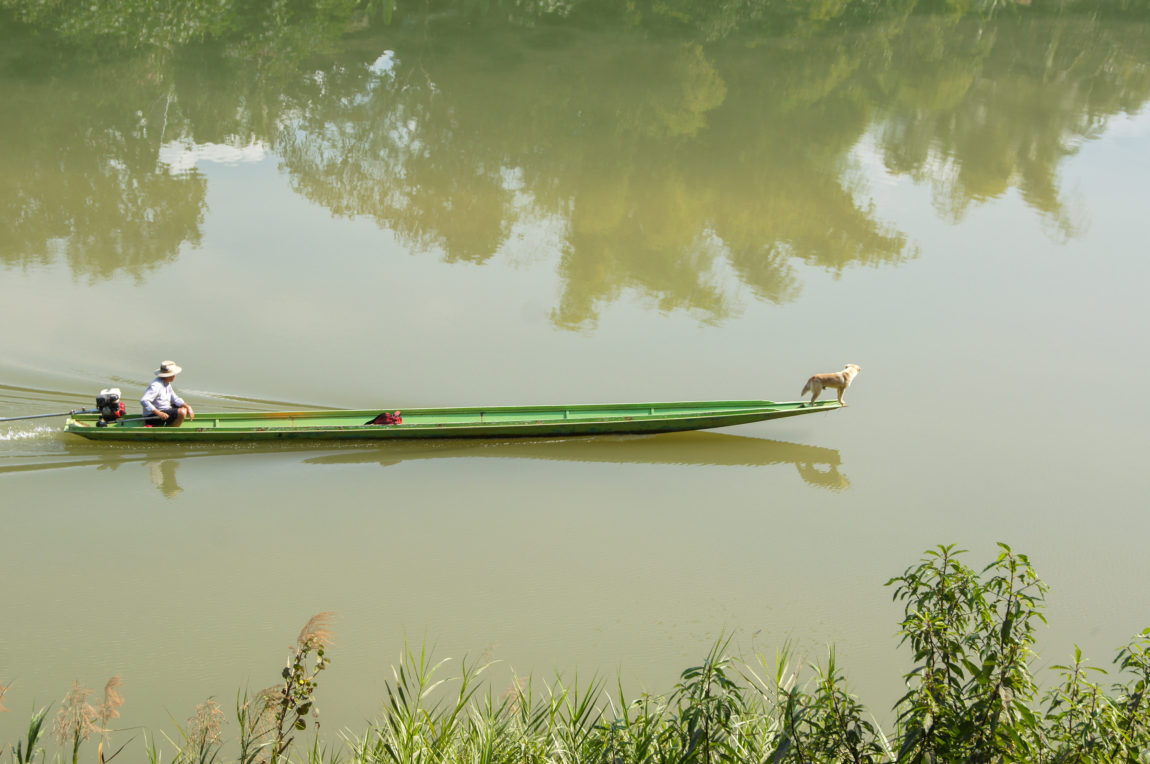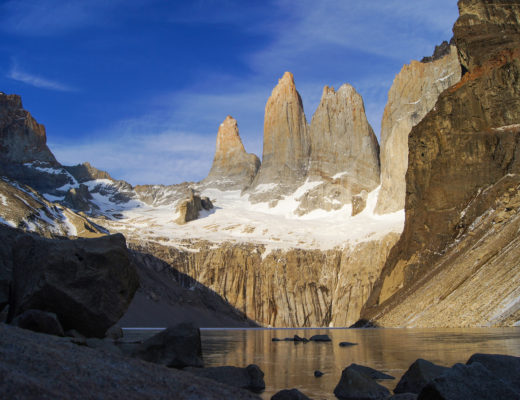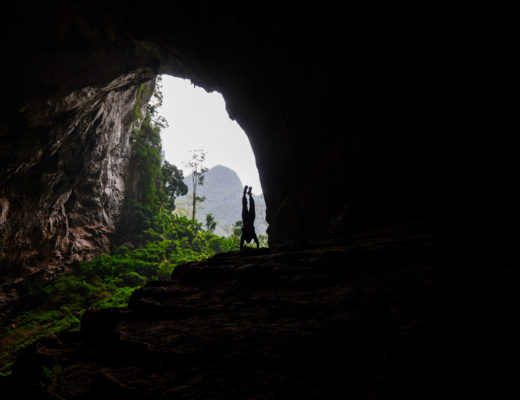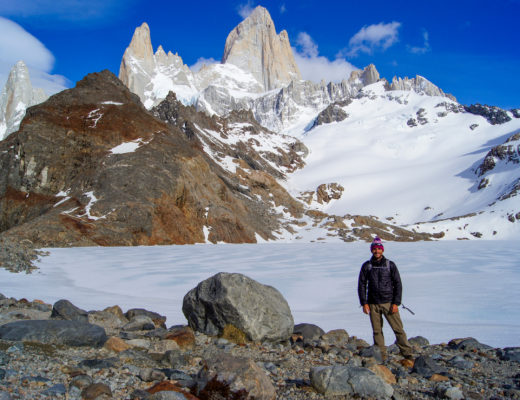Laos, the Next Country on my Southeast Asia Travel Adventure
After Thailand, I journeyed into Laos, the landlocked communist country wedged between Thailand and Vietnam. I had barely heard of Laos, pronounced “Lao”; a country that is nearly half the size of Thailand and home to only 7 million people, or 10% of Thailand’s population. I spent five adventure-packed days in Laos, two of them floating down the Mekong River.
Journey from Thailand to Luang Prabang, Laos
Britton, my Southeast Asia travel mate, and I set our sights on Luang Prabang, a small city in the north of Laos. Rather than take a plane or bus from Thailand, we opted to reach Luang Prabang by boat. More specifically, we decided to reach our destination by floating for 15 hours down the famous Mekong River on a riverboat, widely referred to as “the slow boat“.
The journey to the starting point for the slow boat was an odyssey in itself. From Pai, Thailand, it took four bus rides totaling 10 hours and two tuk-tuk rides to reach the departure point for the slow boat. The most memorable segment of this journey was a 6 am local bus from Chiang Rai to Chiang Khong, Thailand.
The three hour bus journey across Thailand’s northeast countryside seemed to last forever. We bounced along the ill-maintained roads, picking up and dropping off farmers and school children along the way. During the ride, I was afraid my pack, hastily tethered to the top of the rickety old school bus, would no longer be with us when we reached our destination. Meanwhile, the toothless Thai grandma “sharing” the bus bench with me refused to slide over to give me enough space for my left butt-check. But, who was I to ask for anything more: how many thousands of pounds of rice had I picked over my lifetime? It wasn’t pretty but, eventually, my pack and my left butt-check arrived safely. Travel isn’t always as glamorous as it appears on Instagram.
Floating Down the Mekong River
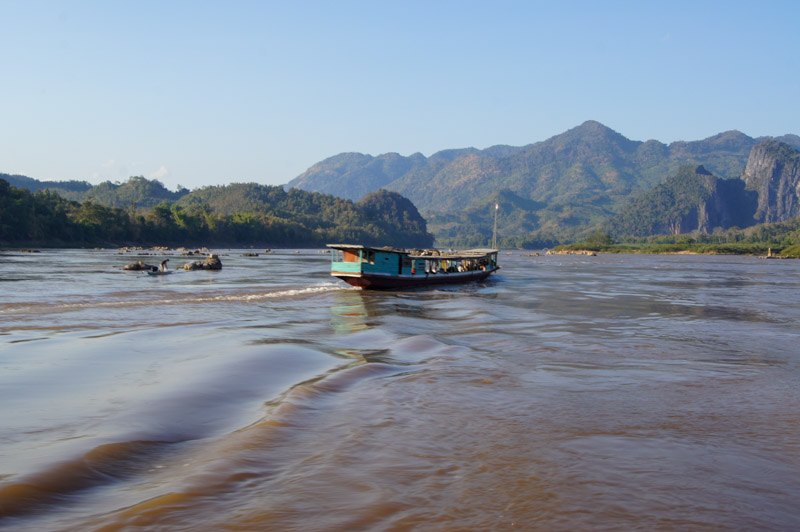
We boarded our Mekong “chariot” at a small port in northern Laos. And by port, we are talking about three or four riverboats tethered to the banks of the Mekong. We began the journey with approximately 125 – 150 passengers; slightly more than half were backpackers, the rest Laotians. Unexpectedly, the riverboat seats had been hijacked from old vans and were not bolted to the boat’s floorboards, so we slid around a bit once seated. I was surprised there was a seat for everyone. No one made reservations, no one was turned away, and every single seat was claimed. The magic of Southeast Asia: don’t ask questions and somehow things will work out just fine.
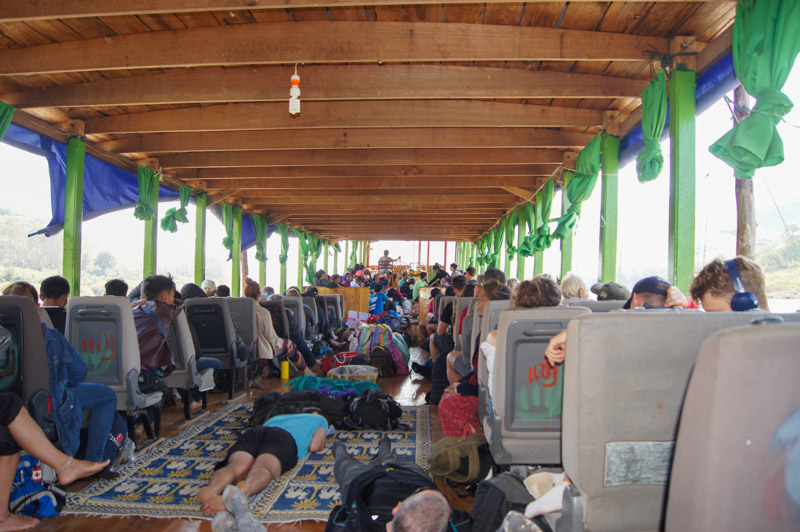
Disappearing Laotians
At un-announced intervals the boat would suddenly pull over to one side of the river and, using a houseboat or boulder as a makeshift dock, locals would deftly climb ashore. Often, the Laotians would depart the boat supporting large heavy nylon sacks atop their heads. I tracked the departed passengers as they walked onto land and then, like magic, disappeared into the dense jungle. It reminded me of the scene in the film Field of Dreams, when the baseball players disappear, without a trace, into Kevin Costner’s corn stalks. I’ll never forget that image of the disappearing Laotians.
After 8 hours of slowly puttering down the Mekong, we docked at Pak Beng, a tiny Laos village, located at the mid-way point, to spend the evening.
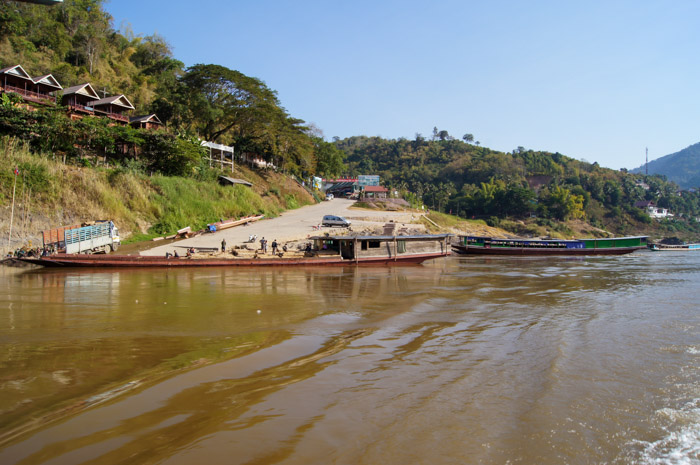
The First Joggers in the History of Pak Beng
The next morning, Britton and I woke to the sound of elephants trumpeting and roosters crowing. We laughed and agreed that this alarm clock certainly beat the blaring ambulance sirens we were used to hearing in New York City. We decided to go on a morning jog and set off at a leisurely pace down the village’s main road.
All along the dirt road locals were burning rubbish in small uncontained fires. The smoke from these fires filled my lungs and brought tears to my eyes. Before long, we started to attract the attention of the locals. We were convinced the locals had never seen foreigners drifting this far into their village. Also, we speculated that the act of jogging was probably rare or even unprecedented in Pak Beng. A pack of young Laotian boys joined us on our return. Struggling to keep our pace, they laughed merrily and smiled widely at us, before dropping off one by one. Sometimes, a morning jog is all it takes to experience travel magic.
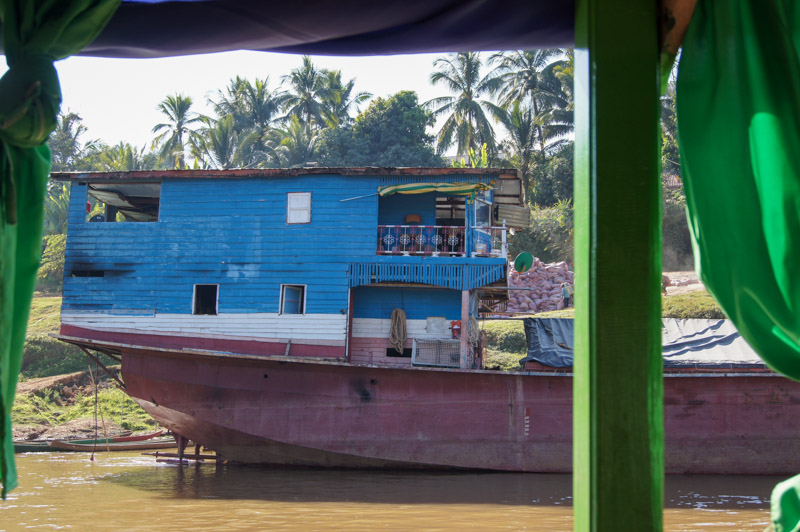
Our First-Class Private Balcony on Day 2 of the Slow Boat
After our morning jog, Britton and I hungrily wolfed down a western breakfast and then hustled to grab a good seat for the second leg of our riverboat journey. When we arrived, the boat was already jam-packed; apparently, we had underestimated the promptness of our fellow passengers. I walked to the back of the boat, unable to locate a single available seat.
Before long, I caught the eye of the boat captain and he gestured at me to follow. Obediently, I followed the man to the boat’s stern: we tiptoed around the boat’s motor, which was dangerously exposed out of the center of the floorboards; then, we carefully navigated our way across a mountain of backpacks. We stepped through a small door, and suddenly I found myself on the boat’s back patio. For once, the travel gods awarded me for my tardy arrival. I smiled and gave the thumbs up to the captain, and then hurried back to the front of the boat to grab Britton and show off the first-class accommodations I had scored for us.

Our experience on the second day of the slow boat journey down the Mekong far surpassed our previous day’s experience. Instead of being cooped up in a stuffy and crowded room, exposed to the constant jarring roar of the boat’s engine, we enjoyed unobstructed views and a cool breeze on our private and quiet balcony. A few amicable and garrulous Australian backpackers, Jack and Ash, discovered our good fortune and joined us on our porch for a few hours. We shared travel experiences and had fun debating the best and worst features of each of our respective countries. After a calm and comfortable seven hours of floating down the river, Britton and I excitedly disembarked in Luang Prabang. It had taken the better part of three days of traveling, but we had finally arrived.
Luang Prabang, the Perfect Mix of Backpacker and Cultural Experiences
Luang Prabang was exactly what I was looking for in Southeast Asia, and the city made a strong impression on me. In Luang Prabang I found the perfect mix, good backpacker friends with exposure to locals and entirely new cultural experiences. Below I have recounted my most memorable Luang Prabang experiences.
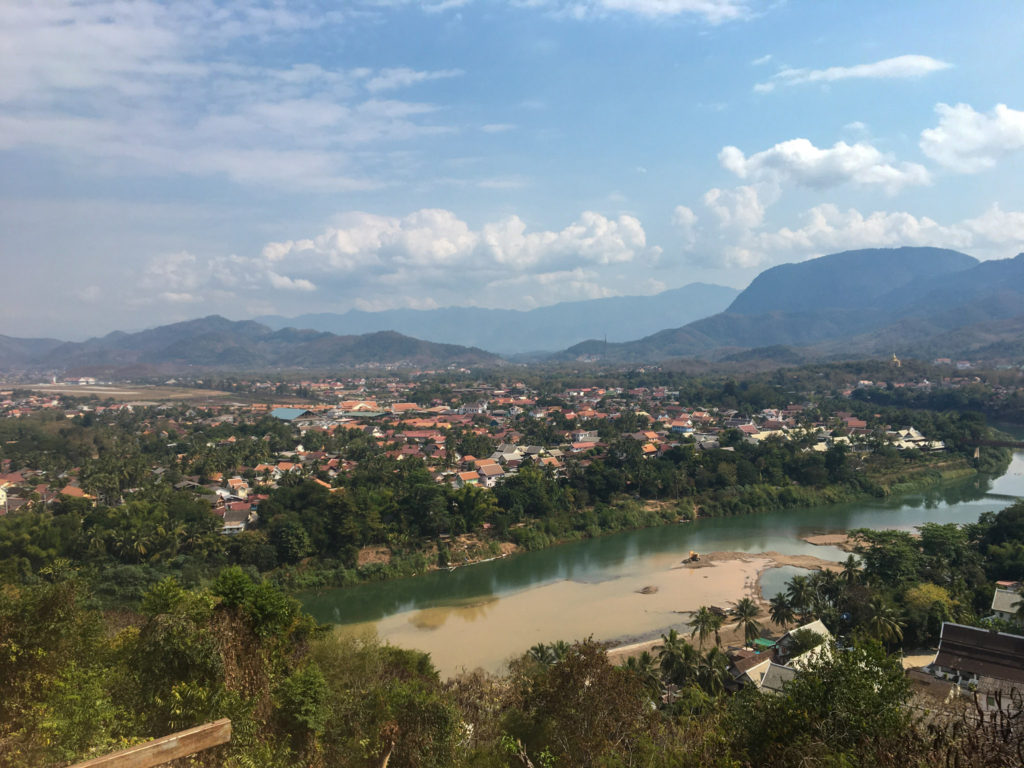
Attending a Buddhist prayer ceremony and conversing with a local monk. During my first night at the hostel, I befriended Fernando, a confident and affable Peruvian, who shared my thirst for adventure. While wandering among one of the many temples scattered throughout Luang Prabang, Fernando met a Buddhist monk named Tong. Tong invited Fernando to attend a prayer ceremony, and Fernando was kind enough to invite me and Britton to tag along.
Try to picture three white foreigners, sitting quietly at the back of the Buddhist temple, sweating while futilely trying to maintain proper posture. At the front of the temple sat two dozen monks, all chanting loudly in unison for one hour. We must have looked ridiculously out of place. Afterwards, we had the incredible opportunity to met with Tong and learn about his life as a Laotian monk. Tong’s English was impressive, especially for having never left the country. He was open to all of our questions and was extremely interested in our lives and the world outside of Laos.
We strolled through the Luang Prabang night market with Tong and one of the young novice monks, a boy of around 12 years old. At one point, we encountered a number of local boys, and I was surprised when they bowed reverently before the young monk. Before parting, Tong advised me to return and start a business in Laos. Our conversation reminded me of just how far I had traveled from home, and how another adult male who was the same age as me, could live such a disparate life.
Bowling in Luang Prabang. In Luang Prabang all the bars and restaurants shut down at 11:30 pm. The only place that remains open is the bowling alley. As a result, everyone, travelers and locals alike, descend upon the alley at the stroke of midnight.
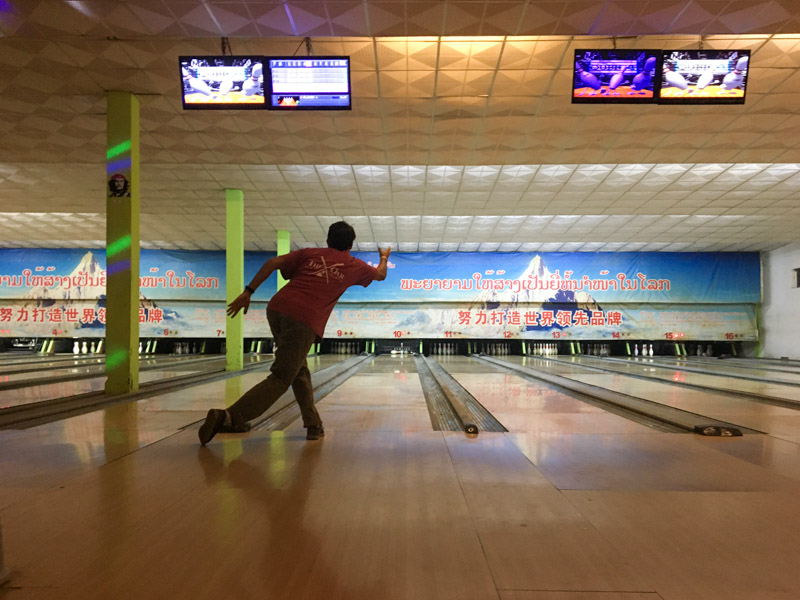
After spending time with Tong, our Laotian monk friend, we grabbed some food and hit up the hostel for the open bar. I’ve never stayed at a hostel with an open bar, and this complimentary service was all the more impressive as The Mad Monkey hostel in Luang Prabang was the cheapest hostel I have ever stayed at, setting me back only 4.50 USD a night.
After some hostel music trivia, four of us headed over to the bowling alley to see what the hype was all about. The amazing crew that evening, consisted of Britton, Russell, an amiable and delightful Singaporean-American, and Olivers a hilarious and jovial young Swede. Before we knew it, we were in our fourth game, we were sharing our second handle of 5 USD bowling alley whiskey, and we were cheering on and high-fiving with locals in the next lane over.

Kuang Si Waterfalls. On my last day in Luang Prabang, we rented mopeds and scootered one hour, through the Laos countryside, to the Kuang Si Waterfalls. The gang that day was comprised of me, Britton, Fernando, and Govind, a chatty and well-traveled Indian fellow from our hostel.
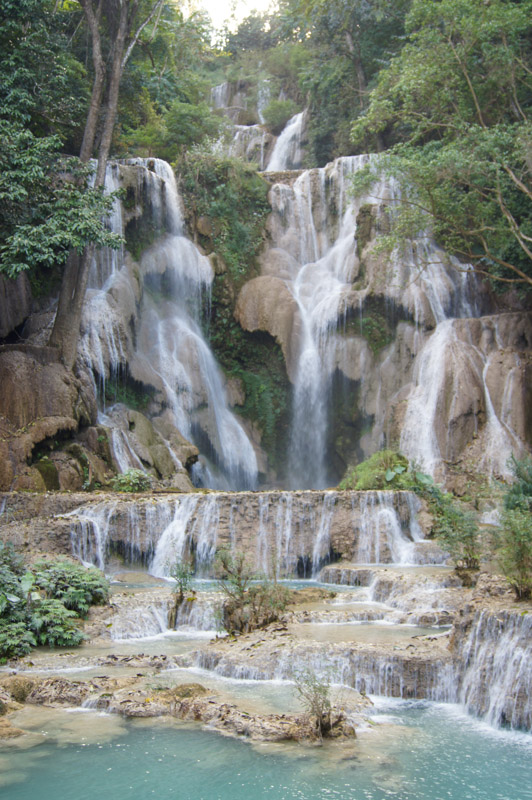
It is difficult for waterfalls to impress me ever since visiting the great and powerful Iguazu Falls, but the Kuang Si Waterfalls, nestled in the lush Laos jungle, exhibited a fairytale-like quality, that blew me away. Rather than impress with power, these cascading falls impressed with finesse. At these waterfalls, the water flows down multiple tiers, softly bouncing off rock formations that look like giant mushroom caps. Eventually, the water funnels together and continues down the mountainside, overflowing from one gorgeous infinity-edge turquoise pool to the next.
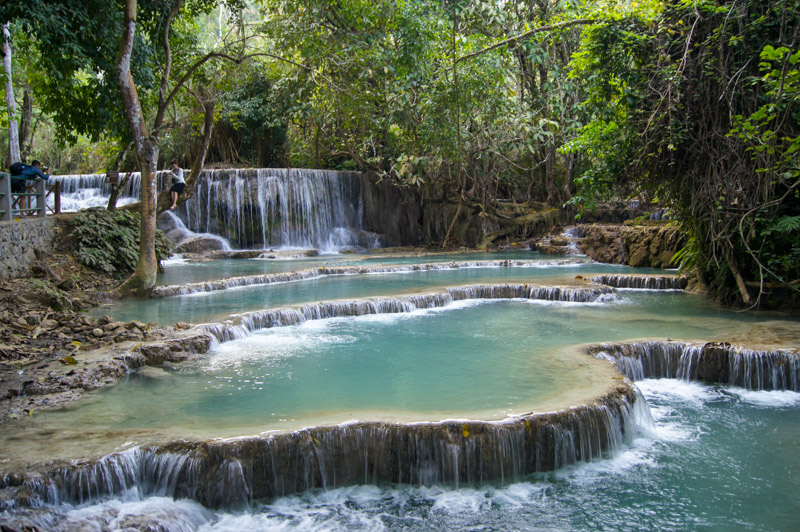
I especially enjoyed the steep 20 minute hike up to the source of the cascading waterfalls. The base of the waterfall was crowded with tourists but, incredibly, very few people ventured up to the top of the falls. At the precipice of the falls, we jumped into clear pools that were the source of the falls. Then, after descending the trail, we splashed around in as many of the turquoise pools as we could. Classic Britton and Tanner style, we acted a bit ridiculous, Tarzaning from one pool to the next, and squealing when minnows nibbled on our toes and legs.
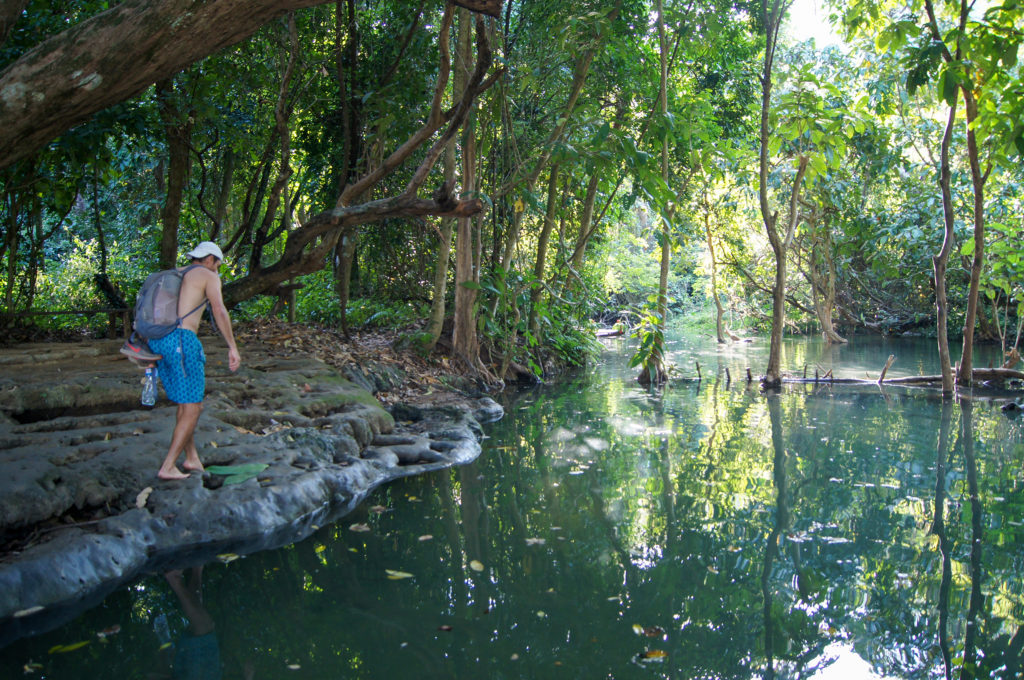
Laos village haircut. On the return journey from the Kuang Si Waterfalls, I stopped at a tiny village barbershop. This stop turned out to be an extremely memorable experience. Check out my blog post on the Laos village barbershop experience.
My Laos Conclusions
Not many backpackers venture to Laos, but of all the Southeast Asia countries I have visited, it is the one I wish to return to most. There is certainly some magic in this lush and relatively unexplored country. My experiences in Laos were so outlandish, it feels as if they all occurred in dream. Floating down the Mekong, jogging with locals in Pak Beng, conversing with a Buddhist monk, bowling and bowling-alley bottle service with locals… what an insane and unforgettable adventure.

Side Note: Eye Opening Adventures On the Other Side of the World
I love my country and I am very proud to be an American, but sometimes I am not proud of our past. While traveling in Laos, I learned that between 1964 and 1973 the U.S. dropped 270 million bombs on Laos during a secret military operation. To put that number in perspective, this is more than all the bombs dropped by all the countries combined during WWII. It is estimated that 80 million of these bombs did not explode on impact and still remain active today, buried all over the country. It has been fifty years since the bombings, yet hundreds of Laotians still die from these unexploded bombs each year. Back home, I live in a sheltered bubble, and traveling has enlightened me and inspired me to contribute to certain causes. Since visiting Laos, having an opportunity to interact with these lovely people, and learning about these bombings, I have been contributing to The Halo Trust, a non-profit organization, dedicated to removing landmines in worn-torn communities across the globe.

